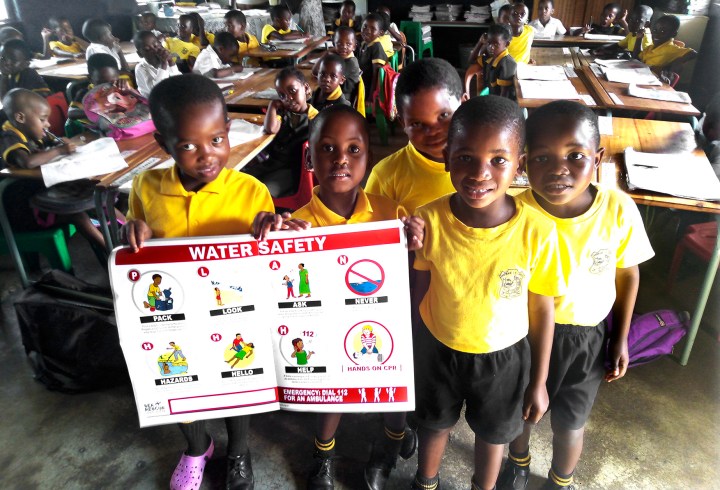Drowning prevention
NSRI: Saving lives and creating futures through water safety education

It is estimated that 600 children die by drowning in South Africa each year. The National Sea Rescue Institute reports that most child drownings are in rural areas, where children under the age of five drown around the house in buckets, basins, baths, or pit latrines.
The National Sea Rescue Institute (NSRI) was established in 1967 following the drowning of 17 fishermen during a severe storm near Mossel Bay. Their mission: to be the most admired and trusted rescue organisation in South Africa, inspiring volunteers to join and stay, ensuring that funders are proud to be associated with them, and building national pride.
The organisation has two divisions: the first is the rescue division; the second was established in 2006 when the NSRI launched its drowning prevention initiative through teaching water safety.
“Our goal is to prevent drowning through education, through preventative measures, and through rescue. We aim to reduce the large number of people who die from drowning every year, 600 of these being children,” says NSRI volunteer and spokesperson Slindile Mkhize.
The NSRI is a non-profit organisation staffed solely by volunteers who are on call 24/7. The rescue division currently has 1,351 volunteers, while the drowning prevention division has 21 water safety instructors based in Gauteng, KwaZulu-Natal, Eastern Cape, and Western Cape.
Many drownings occur inland in disadvantaged areas where children under the age of five drown around the house in buckets, basins, baths, or pit latrines. Instructors have become creative in how they teach water safety.
“The water safety instructors throughout the country teach classroom-based lessons to creches, schools, clinics, and community groups about water safety, what to do in an emergency, and how to do bystander CPR,” says Mkhize.
The NSRI has also built an online training academy for their crew and extended this platform to include free courses for the public – a feature that was welcomed during levels 4 and 5 of the national lockdown.
According to the NSRI, people often swim at beaches where there are no lifeguards present:
“A typical scenario is the NSRI gets an emergency call for a swimmer in difficulty and, when we get there, we find two or more people in danger of drowning.
‘Tragically, sometimes we are not able to get there in time and someone drowns. Usually, the person who does not survive is the kind person who went into the water to try and help a person in difficulty.”
Because this happens so frequently, the NSRI launched their Pink Rescue Buoy project in November 2017. Flotation devices (buoys) are strategically placed on a pole on a beach, and in an emergency bystanders can remove the buoy and throw it to the person in the water, which will help them float until further help arrives.
Since the project’s inception almost three years ago, the buoys have saved nearly 60 lives. The latest initiative in drowning prevention, which is yet to be rolled out to all the provinces, is survival swimming lessons.
“Survival swimming includes teaching water safety in a swimming pool. Here children are taught what to do if they are in difficulty in water,” says Mkhize.
Survival swimming does not provide lessons on how to swim, but rather on how to survive if you find yourself in a dangerous water situation.
Mkhize adds that people do not realise that possible death is not the only consequence of drowning: those who experience non-fatal drownings may have life-long disabilities.
A common consequence of drownings is oxygen deprivation and suffocation within five minutes. This traumatic event causes brain cell death which can lead to an anoxic brain injury – a disorder that causes severe, permanent neurological damage.
Mkhize says to keep children safe, parents must ensure “that after doing house chores like washing or cleaning they should empty all tubs, basins, and bathtub water. If they have a pool, they must install a pool safety net.
“Children need constant supervision when they are in, on or around the water; don’t allow them to play alone near water or assume that someone is watching your child or children.”
Mkhize explains that rivers and dams also pose a significant risk to children, especially when they are unsupervised. If you live near a dam or river, Mkhize says that you can reduce the risk of drowning for yourself and your children by practising the following:
- Always ask: “Am I safe?”
- Do not attempt to cross a river in flood.
- Be aware that the water depth in dams and rivers can quickly change.
- Be aware of slippery stones or rocks. These can injure or cause you to fall into the water.
- Consider how fast the water is flowing.
- Never swim alone even if you are a good swimmer, always swim with a friend; never jump or dive in if you cannot see what is in the water.
- It is extremely dangerous to get into water to rescue someone, rather throw something that floats to the person in difficulty, like a rope, or hold out a long stick/pipe to that person and call 112 for help.
- Always face the water as slips happen so easily.
- Water collected should be stored safely and out of reach of young children.
- Can someone in your area sponsor the erection of a Pink Rescue Buoy near the dam or river? These are used to provide peer rescue, without the one helping endangering themselves.
- Learn how to do hands-on CPR.
Mkhize reminds us that drowning is silent – do not become another statistic, ensure that any water in and around your home is child safe. DM/MC
Contact Slindile Mkhize at [email protected] if you require water safety lessons at your organisation. You can also sponsor a Pink Rescue Buoy for your area.





















 Become an Insider
Become an Insider